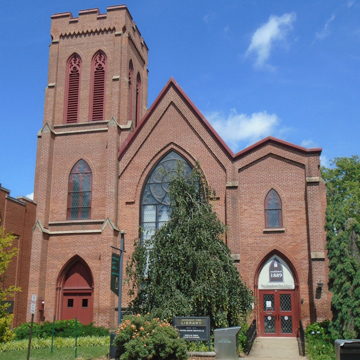You are here
Osterhout Free Library
Renwick sent his designs for Wilkes-Barre's First Presbyterian Church from New York City by canal boat, an insight into how the city received its architectural influences—and at what speed. The Gothic Revival hallchurch, with three aisles of equal height, was handsomely adapted to serve as a library, after the completion of the current church in 1890 in the same block. The lovely Tudor-style reading room and stack wing were added in 1907 by Welsh, Sturdevant and Poggi, while Eyerman Csala Hapeman added a sympathetically contextual wing in 1983. The Osterhout shares a side lawn with the Westmoreland Club at 59 South Franklin Street (1897, E.G.W. Dietrich), an institution synonymous with the region's high society. Dietrich designed this suave gray brick Georgian Revival, its swelling bays belted by Ionic pilasters, as a private residence. In 1920, Clark Wright Evans, who had worked in New York before relocating to Wilkes-Barre, supervised its transformation into a new home for the elite city club. The design reflects the turn toward more accurate emulations of early American design.
Writing Credits
If SAH Archipedia has been useful to you, please consider supporting it.
SAH Archipedia tells the story of the United States through its buildings, landscapes, and cities. This freely available resource empowers the public with authoritative knowledge that deepens their understanding and appreciation of the built environment. But the Society of Architectural Historians, which created SAH Archipedia with University of Virginia Press, needs your support to maintain the high-caliber research, writing, photography, cartography, editing, design, and programming that make SAH Archipedia a trusted online resource available to all who value the history of place, heritage tourism, and learning.







